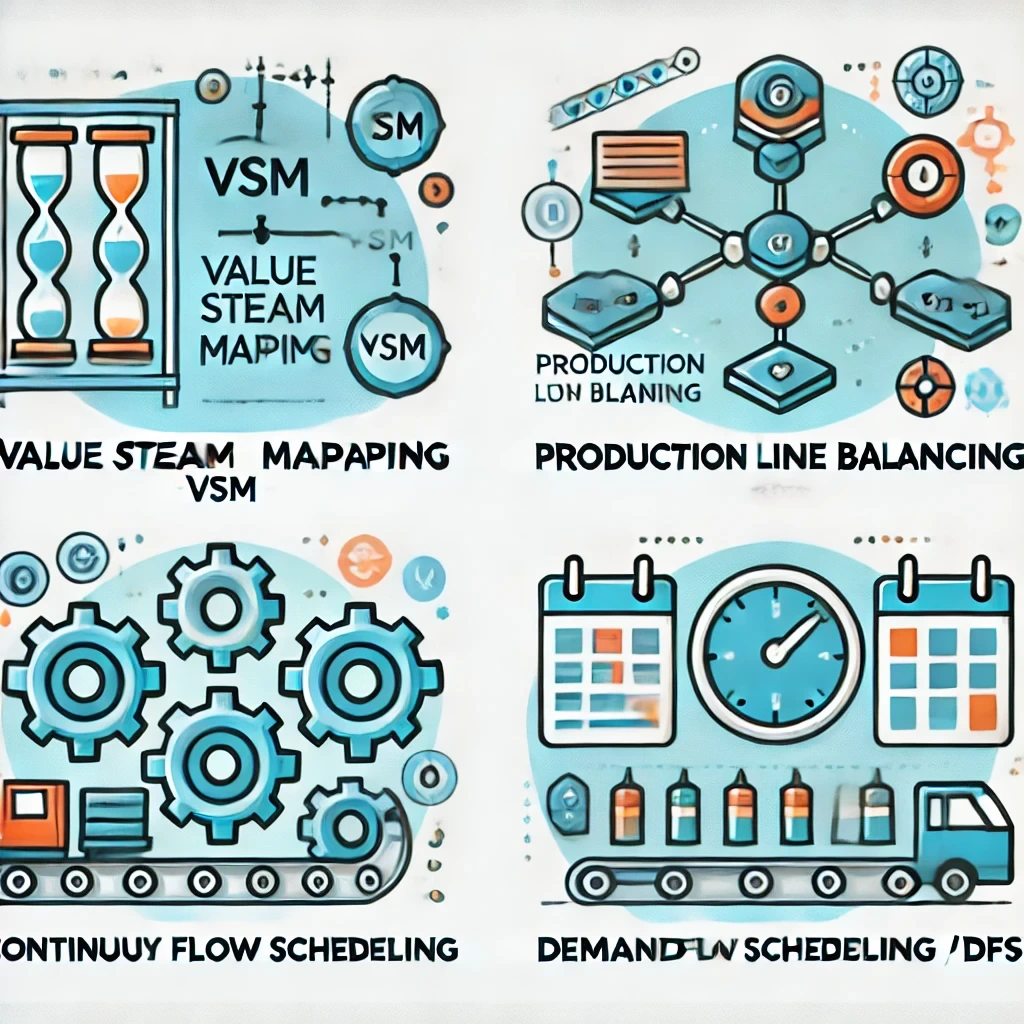
Introduction to Demand Flow Technology (DFT)
Demand Flow Technology (DFT) is a powerful manufacturing methodology that aligns production processes directly with real-time market demand. Unlike traditional forecast-driven approaches, DFT emphasizes producing exactly what is needed when it’s needed, leading to improved production efficiency, reduced waste, and enhanced responsiveness to changes in consumer demand. Originating from principles similar to Lean Manufacturing and Just-In-Time (JIT), DFT is designed to optimize production flow by focusing on customer needs. In this article, we will explore the principles, benefits, and implementation strategies of Demand Flow Technology, positioning it as a critical tool for manufacturers seeking a competitive edge.
What is Demand Flow Technology (DFT)?
Demand Flow Technology focuses on creating a production system that is directly responsive to customer demand. By synchronizing production processes with real-time orders, DFT allows manufacturers to:
- Eliminate overproduction and excess inventory
- Enhance flexibility in adapting to demand changes
- Improve overall production efficiency and flow
This demand-driven approach helps companies minimize the gap between production and market needs, ensuring a more agile response to fluctuations in demand.
Core Principles of Demand Flow Technology
1. Demand-Driven Production
The foundation of DFT is to align production with customer demand rather than relying on forecasts. This shift from forecast-driven models to demand-driven systems helps to maintain leaner inventories and minimizes stockpiling, reducing costs and waste.
2. Flow Management
DFT emphasizes smooth and consistent flow across production lines. It focuses on maintaining a balanced flow that can adapt to changes in demand, ensuring that every step in the manufacturing process is efficient and synchronized.
3. Synchronization with Real-Time Demand
DFT ensures that production processes are synchronized with customer orders and market conditions. This is achieved through continuous monitoring and adjustment, allowing companies to quickly ramp up or slow down production as needed.
4. Takt Time
Takt time is a crucial concept in DFT, representing the rate at which products must be produced to meet customer demand. By calculating takt time, manufacturers can better manage production pace, ensuring that output aligns perfectly with demand.
Key Components of DFT Implementation

Value Stream Mapping (VSM)
Value Stream Mapping is a vital tool in DFT for identifying non-value-adding activities in the production process. It helps to streamline processes, eliminate bottlenecks, and optimize the overall flow of production.
Production Line Balancing
Balancing production lines ensures that resources are used efficiently across different stages of manufacturing. By distributing tasks evenly, DFT minimizes idle time and maximizes throughput.
Continuous Flow Concepts
Continuous flow is a core aspect of DFT, achieved through methods like Kanban and pull systems. These approaches help manage inventory levels and ensure that materials are only supplied when needed, further reducing waste and excess stock.
Demand Flow Scheduling (DFS)
Demand Flow Scheduling helps align production schedules with customer orders, allowing companies to adjust production plans based on real-time demand data.
For more interesting blogs, visit our site: https://futuretrendz.co.uk/
Benefits of Demand Flow Technology
1. Enhanced Efficiency
DFT helps manufacturers reduce lead times and streamline production processes, leading to faster delivery of products to the market.
2. Cost Reduction
By aligning production with demand, companies can significantly reduce inventory costs, minimize waste, and lower operating expenses.
3. Flexibility and Adaptability
DFT enables manufacturers to quickly adjust production volumes in response to market changes, making it ideal for industries with fluctuating demand.
4. Improved Customer Satisfaction
Meeting customer demand more accurately results in fewer stockouts, shorter wait times, and higher levels of customer satisfaction.
Case Study: Automotive Industry
A leading automotive manufacturer implemented DFT and saw a 25% reduction in inventory costs while cutting production lead times by 15%. This allowed the company to better meet the demand for specific models, improving market share.
Comparison: DFT vs. Other Manufacturing Methodologies
Demand Flow Technology vs. Lean Manufacturing
While Lean focuses on eliminating waste throughout the production process, DFT specifically targets aligning production with real-time demand. Both methods can complement each other, but DFT offers a more dynamic response to market changes.
DFT vs. Just-In-Time (JIT) Production
JIT focuses on reducing inventory and delivering products as they are needed, similar to DFT. However, DFT places a greater emphasis on aligning the entire production flow with demand fluctuations, offering more flexibility.
DFT vs. Six Sigma
Six Sigma aims to reduce variability and improve quality in manufacturing processes, while DFT focuses on synchronizing production flow with demand. When used together, they can optimize both quality and responsiveness.
The Role of Technology in Demand Flow Implementation

Use of Software Tools
DFT relies on software for real-time monitoring and demand analysis. These tools help manufacturers track demand patterns, automate scheduling, and adjust production lines accordingly.
Integration with ERP Systems
Enterprise Resource Planning (ERP) systems play a critical role in DFT by providing a centralized platform for managing demand data, inventory levels, and production schedules.
Data Analytics and IoT
By leveraging IoT sensors and data analytics, manufacturers can gain deeper insights into demand trends and production performance, enabling more accurate adjustments to the flow.
For more interesting blogs, visit our site: https://futuretrendz.co.uk/
Step-by-Step Guide to Implementing DFT
Step 1: Assess Readiness for DFT
Evaluate current production processes and identify areas where demand flow could improve efficiency.
Step 2: Develop a Demand Flow Strategy
Analyze customer demand patterns to create a strategy that aligns production schedules with market needs.
Step 3: Design Flow Lines
Design balanced production cells that minimize bottlenecks and ensure smooth flow.
Step 4: Train Employees
Create a culture of demand responsiveness by training employees on the principles of DFT and how to adapt to real-time changes.
Step 5: Continuous Improvement
Regularly monitor production performance and adjust flow processes to maintain alignment with demand.
Challenges and Pitfalls in Implementing DFT

1. Resistance to Change
Shifting from traditional manufacturing methods to DFT can encounter resistance from employees. Effective change management strategies are crucial.
2. Demand Data Accuracy
Accurate demand data is essential for DFT. Implementing reliable data collection systems and forecasting methods can mitigate this challenge.
3. Technical Integration
Integrating new software and ERP systems can be complex. Ensuring compatibility and providing adequate training can help overcome technical hurdles.
4. Cultural Shift
A shift to demand-driven production requires a change in organizational culture, emphasizing flexibility and responsiveness.
For more interesting blogs, visit our site: https://futuretrendz.co.uk/
Short FAQs About Demand Flow Technology
What is Demand Flow Technology (DFT)?
Demand Flow Technology is a production methodology that aligns manufacturing processes directly with real-time customer demand, optimizing efficiency and reducing waste.
How does DFT differ from Lean Manufacturing?
While Lean focuses on waste reduction, DFT targets the alignment of production with customer demand, offering more dynamic responsiveness to changes.
What industries benefit most from DFT?
DFT is particularly useful in industries with fluctuating demand, such as automotive, electronics, and consumer goods.
What are the challenges of implementing DFT?
Common challenges include resistance to change, the need for accurate demand data, and integrating new technology into existing systems.
Can DFT be combined with other methodologies?
Yes, DFT can complement Lean, Six Sigma, and JIT methodologies, creating a more holistic approach to efficient and adaptable manufacturing.
Conclusion
Demand Flow Technology is transforming how manufacturers align their production processes with real-time demand. By focusing on flow management, synchronization, and responsiveness, DFT enables companies to reduce costs, improve efficiency, and adapt quickly to market changes. With a strategic approach to implementation and the right technological tools, DFT can provide a significant competitive advantage in today’s dynamic manufacturing landscape.
Learn more about emerging trends at Future Trendz.







